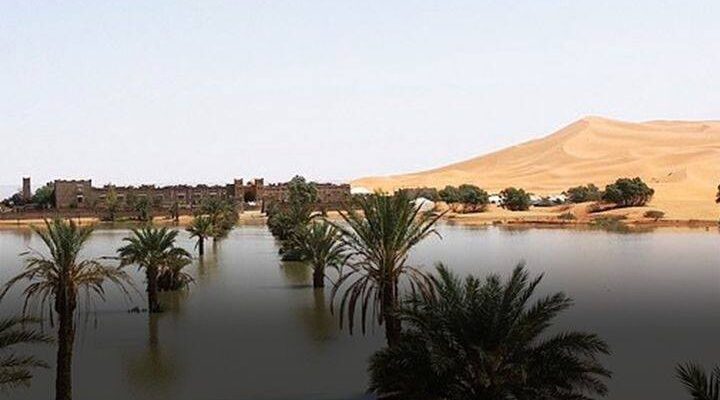
Sahara Desert Struck By Flood, Filling Lakes That Have Been Dry for 50 Years
In a stunning twist of nature, one of the world’s driest and most unforgiving landscapes, the Sahara Desert, has experienced an unprecedented flood. Torrential rainfall in September has filled lakes that had been dry for decades, transforming parts of the arid desert into temporary oases.
Rare Rains Bring a Watery Transformation

Over two days in September, southeastern Morocco witnessed record-breaking rainfall. In Tagounite, a village about 450 kilometers south of Rabat, more than 100 millimeters (3.9 inches) of rain fell in just 24 hours—a figure that surpasses the region’s annual average. This unexpected deluge has reshaped the Sahara’s landscape, including the dramatic reappearance of Lake Iriqui, a lake bed that had been bone-dry for 50 years.
Satellite imagery from NASA vividly captured the transformation. “It’s been 30 to 50 years since we’ve seen this much rain in such a short time,” said Houssine Youabeb of Morocco’s General Directorate of Meteorology.
The Role of Extratropical Storms and Climate Change

Meteorologists attribute this rare event to an extratropical storm that disrupted typical weather patterns in the region. Such storms can carry large amounts of moisture, causing heavy rainfall in unlikely areas (like the Sahara desert). Experts warn that these types of weather events may become more frequent due to climate change.
“As a result of rising temperatures, the hydrological cycle has accelerated,” noted Celeste Saulo, secretary general of the World Meteorological Organization. “We are facing growing problems of either too much or too little water”.
Filling Lakes and Replenishing Aquifers

The rain not only filled ancient lake beds but also replenished underground aquifers and reservoirs, which are vital for sustaining life in the desert. After six consecutive years of drought that left many farmers struggling, this rainfall offers a glimmer of hope. Some of the Sahara’s reservoirs are reported record refilling rates throughout September, signaling a temporary reprieve for water-strapped communities.
However, experts caution against celebrating too soon. “While this rain may bring short-term benefits, the long-term impact on drought conditions remains uncertain,” said Youabeb.
A Mixed Blessing: Beauty and Tragedy

The rare rainfall has also brought tragedy. More than 20 people lost their lives in Morocco and Algeria due to flooding. Crops were washed away, leaving many farmers devastated. In response, the Moroccan government has allocated emergency relief funds to aid affected regions, including areas still recovering from last year’s earthquake.
Despite the hardships, the floods have created breathtaking sights. In Merzouga, a desert town near Rachidia, newly formed lakes reflect towering sand dunes and palm trees, offering an otherworldly beauty.
What the Future Holds

As climate change continues to alter global weather patterns, events like these may become more frequent in even the most arid regions. The Sahara’s recent transformation serves as a reminder of nature’s unpredictability and the pressing need to adapt to a changing climate.
“These extraordinary floods could signal a shift in regional weather patterns,” Youabeb explained. “More research is needed to understand their long-term implications”.
The once-parched Sahara now offers a rare glimpse of its hidden potential for life, even if only for a fleeting moment.



